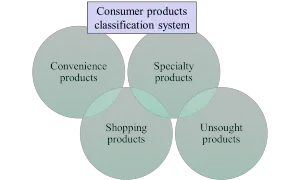In marketing textbooks, when discussing the product mix, it is common to present a classification system for consumer products. Typically, the four following categories are utilized to classify consumer products, and as shown in the below diagram:
Convenience products
Convenience products are those products that consumers purchase on a frequent basis – perhaps even daily. They are usually priced products and the consumer has a very low level of purchase involvement. The purchase decision is typically through habitual loyalty (that is, the consumer purchases the same brand each time) or for a food product the consumer may seek out a different variety, but choosing from a set of regular brands.
Examples of convenience products include: newspapers, soft drinks, snack foods, tissues, bread, milk, toothpaste, soap, using an ATM, cigarettes, and so on.
Shopping products
Shopping products are products that consumers buy on an occasional basis, perhaps every few months or even years. They are usually higher price products and, because of the consumers infrequent purchasing, they will tend to have a higher purchase involvement. That is, they will shop around and consider a product on its merits in comparison to competitive offers.
Examples of shopping products include: a camera, a TV set, household furniture, a new pet, mobile phones, hotel bookings, airline travel, clothing, house renovations, and so on.
Specialty products
Specialty products are products designed to meet a very precise need for a consumer. The consumer is usually more highly involved purchase and will go to significant lengths to obtain the most appropriate brand and product for the needs.
These types of specialty products are only purchase very occasionally, and often the consumer will rely upon the brand/reputation to guide their purchase decision, as well as direct word-of-mouth and social media recommendations.
Examples of specialty products include: expensive cars, building a new house, specialist medical treatment, expensive jewelry, and so on.
Unsought products
As indicated by the name, unsought products are those that the consumer does not deliberately seek out. As a result, these products are typically direct marketed to the consumer, who is not overly involved in the purchase decision.
Sometimes new products are considered unsought products. An example here would be a microwave oven when it was first brought to market in the United States in the 1960s – consumers were already happy with the current kitchen technology and therefore did not seek out and purchase a microwave oven.
Other examples of unsought goods include: insurance, charity donations, new medicines, sometimes breakthroughs in technology (see microwave example above) and various “unusual” products that you may see on late-night TV shopping channels, and so on.
RELATED TOPICS
The consumer products classification system
Examples of the different classes in the consumer products classification system
Why the consumer products classification system is used
The marketing mix for convenience products
The marketing mix for shopping products
The marketing mix for specialty products
The marketing mix for unsought products

